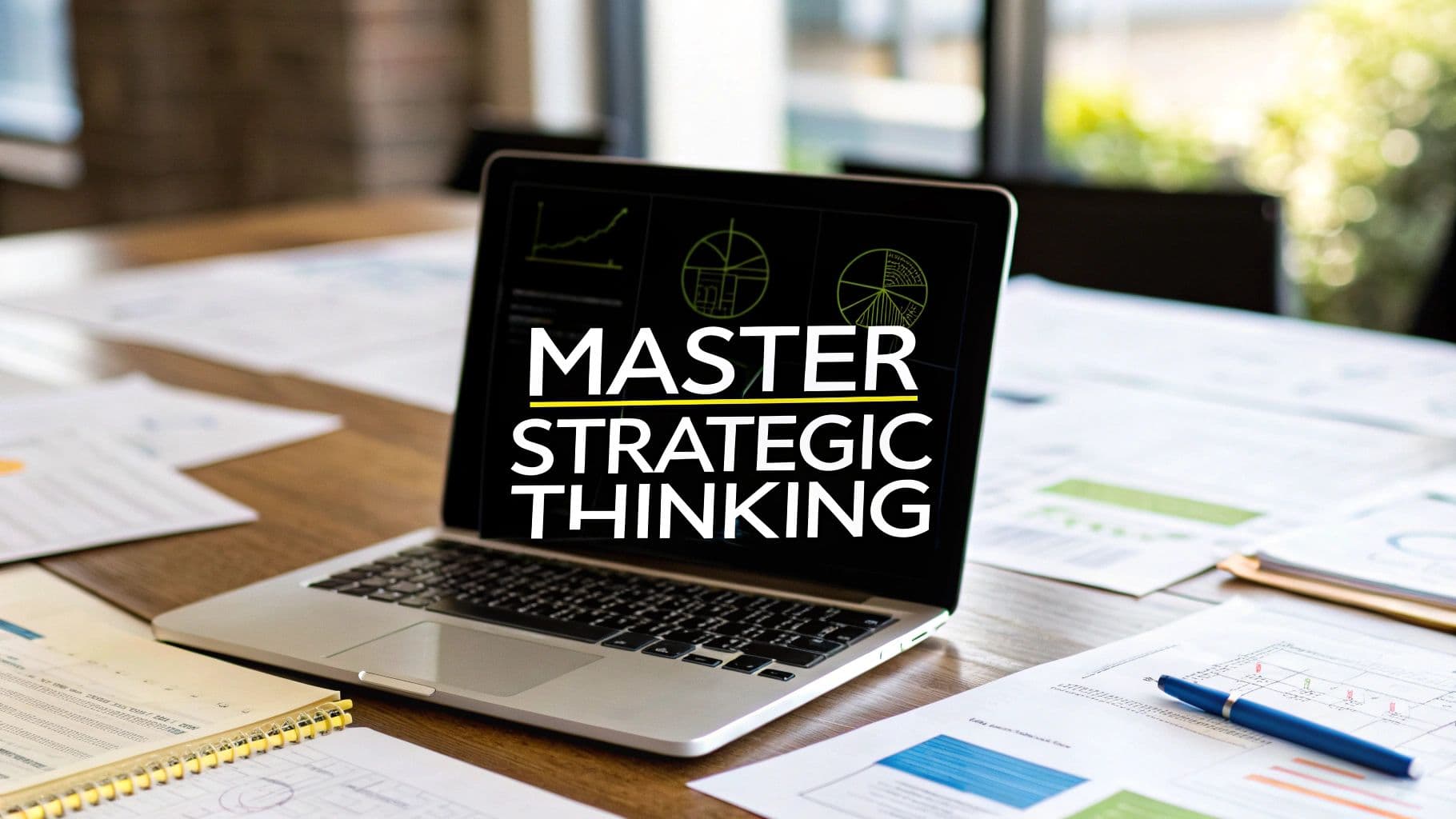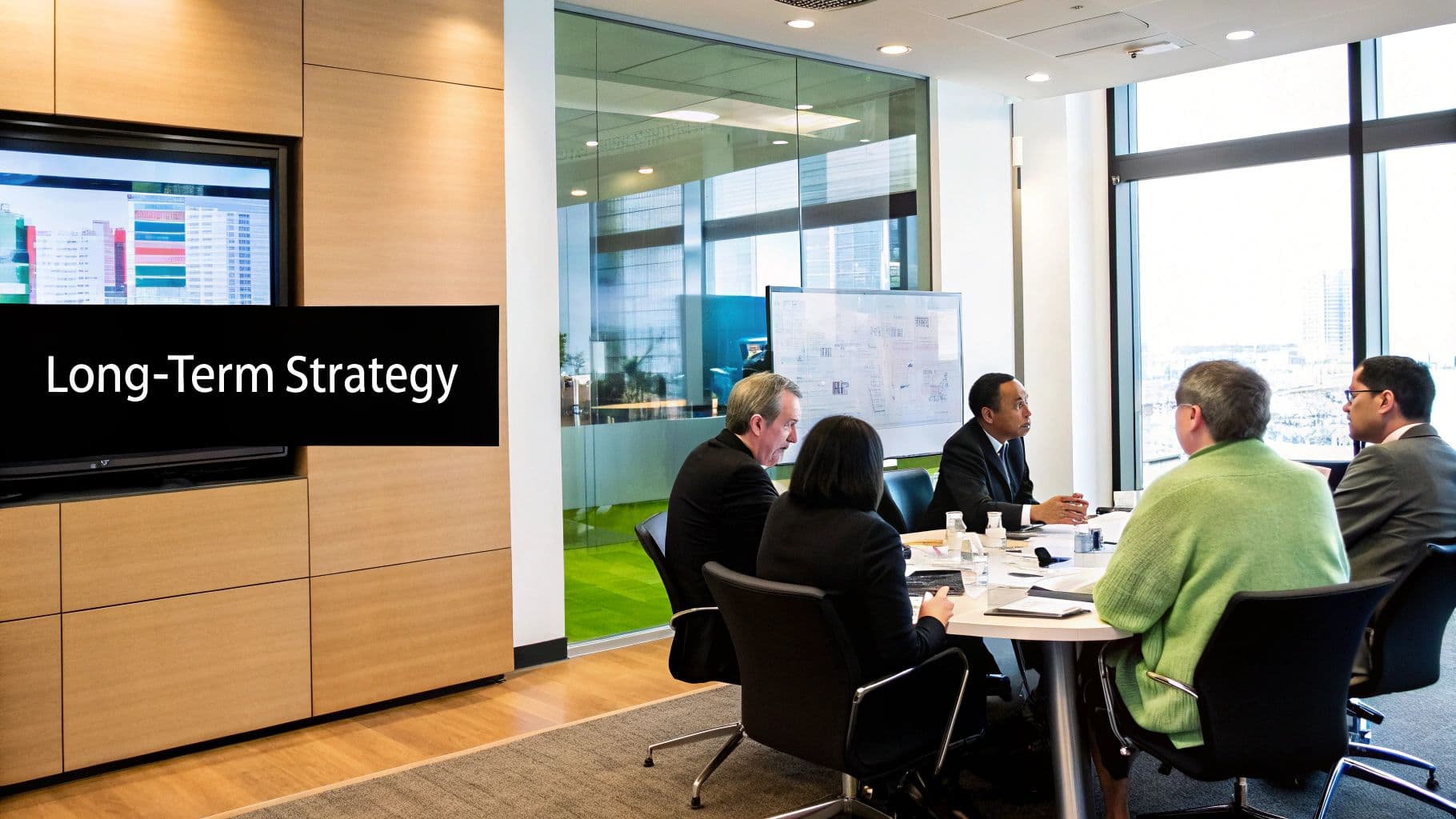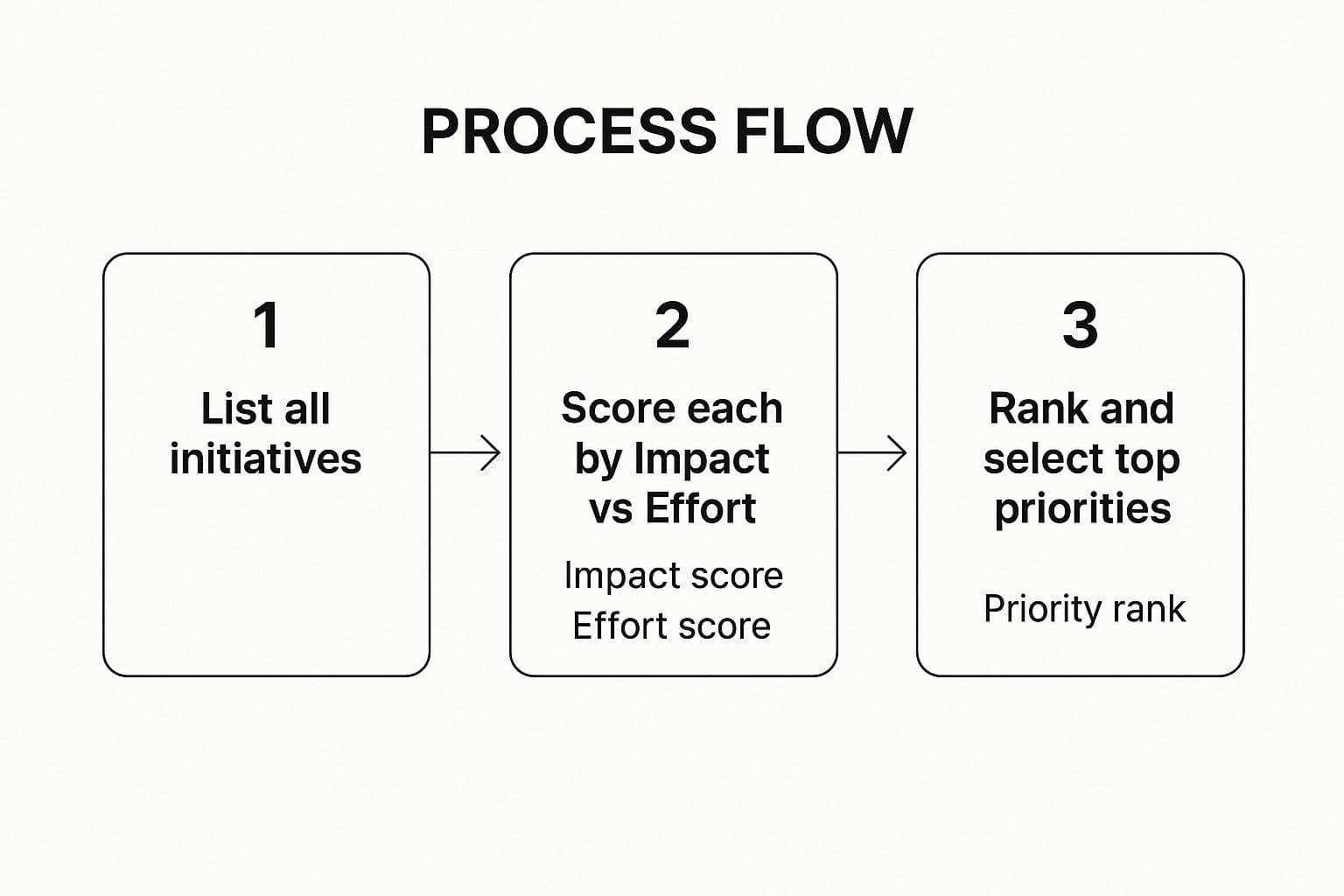8 Strategic Thinking Interview Questions to Master in 2025
Ace your next interview with our deep dive into 8 strategic thinking interview questions. Learn answer frameworks, see examples, and identify red flags.

Strategic thinking is more than just a resume buzzword; it's the ability to see the bigger picture, connect disparate dots, and chart a course through complex, ambiguous challenges. In high-stakes interviews for consulting, finance, and product management, demonstrating this skill is non-negotiable. Interviewers aren't looking for textbook definitions. They are pressure-testing your ability to analyze, prioritize, anticipate, and adapt in real-time. Simply put, they want to see if you can think like a leader.
This guide moves beyond generic advice to provide a concrete, actionable roadmap for acing strategic thinking interview questions. We will break down the 8 essential question types you are most likely to encounter, from developing long-term plans to navigating market entry and strategic pivots.
For each question, you will learn:
- The core competency the interviewer is really assessing.
- A step-by-step framework to structure a compelling answer.
- Sample responses that illustrate a strong thought process.
- Critical red flags to avoid that could undermine your credibility.
Our goal is to equip you with the tools to deconstruct any strategic prompt and formulate a response that showcases your ability to create value and drive long-term success, preparing you to answer with confidence and depth.
1. Tell me about a time when you had to develop a long-term strategy for your team or organization
This is one of the quintessential strategic thinking interview questions because it moves beyond hypotheticals and into real-world application. Interviewers use this behavioral question to assess your proven ability to look past daily tasks, analyze complex situations, envision a future state, and build a concrete plan to get there. It’s a direct test of your capacity for high-level planning and execution.
A strong answer demonstrates your entire strategic process, from initial analysis and goal setting to stakeholder alignment and performance measurement. It shows you can connect a high-level vision to tangible business outcomes, a critical skill for any leadership or strategy-focused role.

How to Structure Your Answer
The STAR method (Situation, Task, Action, Result) provides a perfect framework for a compelling narrative.
- Situation: Briefly set the scene. What was the business context? For example, "Our company was losing market share in the B2B SaaS space due to outdated technology and rising competition."
- Task: Clearly state your objective. What were you asked to do? "My task was to develop a three-year product and technology roadmap to regain our competitive edge and drive 20% year-over-year revenue growth."
- Action: Detail the steps you took. This is where you highlight your strategic capabilities. Explain how you conducted market analysis, gathered stakeholder input, identified key initiatives, and created a phased implementation plan. Mention how you anticipated risks and built consensus.
- Result: Quantify the outcome. Use specific metrics to showcase the success of your strategy. "The strategy was approved and funded. Within two years, we launched three new product modules, which led to a 25% increase in customer retention and a 30% uplift in enterprise sales, exceeding our initial revenue goals."
Key Tips for Success
To make your answer stand out, integrate these key elements:
- Be Specific with Data: Instead of saying "increased revenue," say "increased online revenue by 150% over three years."
- Highlight Collaboration: Explain how you worked with other departments (e.g., Finance, Marketing, Sales) to ensure the strategy was holistic and had broad support.
- Connect to Business Impact: Explicitly link your strategy to overarching company goals like profitability, market expansion, or operational efficiency.
- Address Challenges: Mention potential obstacles you identified and the mitigation plans you put in place. This demonstrates foresight and realistic planning.
2. How do you prioritize competing initiatives when resources are limited?
This is a classic among strategic thinking interview questions as it directly tests your ability to make tough decisions under real-world constraints. Interviewers want to see your decision-making framework, not just your intuition. It reveals your capacity to evaluate trade-offs, assess relative value, and align tactical choices with high-level organizational goals.
A strong answer demonstrates a structured, logical, and data-informed approach. It shows you can balance urgency versus importance, short-term wins versus long-term value, and stakeholder demands versus strategic objectives. This skill is critical in any role where you must allocate finite resources like time, budget, or personnel effectively.
This process flow visualizes a straightforward framework for prioritizing initiatives by assessing their impact against the effort required.

This simple yet powerful sequence ensures that decision-making is systematic, moving from a comprehensive list to a clear, ranked selection of top-priority items.
How to Structure Your Answer
The STAR method is an excellent way to frame your response, grounding your theoretical framework in a practical example.
- Situation: Describe the context. "In my previous role as a Program Manager, we had 15 potential engineering projects for the quarter but only had the bandwidth to complete five."
- Task: State your objective. "My task was to create a defensible prioritization plan to select the five projects that would deliver the most strategic value to the business."
- Action: Explain your process. Describe the framework you used, such as a Value vs. Effort matrix or the RICE scoring model. "I implemented a weighted scoring system, evaluating each project on three criteria: strategic alignment, potential revenue impact, and technical feasibility. I worked with department heads to gather the data for these scores."
- Result: Quantify the outcome. Show the positive impact of your decision. "The final five projects were approved unanimously by leadership. By focusing our resources, we successfully launched a new feature that drove a 10% increase in user engagement and deferred three high-visibility but low-impact projects, saving an estimated $50,000 in development costs."
Key Tips for Success
Elevate your answer by incorporating these specific elements:
- Name Your Framework: Mention a specific prioritization method like RICE (Reach, Impact, Confidence, Effort), MoSCoW, or a value vs. effort matrix to show you have a toolkit.
- Show Your Math: Explain how you gather data to inform your decisions, whether it's through customer interviews, financial modeling, or technical discovery.
- Discuss Stakeholder Management: Explain how you communicate difficult decisions, especially to those whose projects are not prioritized, to maintain alignment and morale.
- Acknowledge Opportunity Cost: Show you understand that choosing one initiative means actively not choosing another, and explain how you weighed that trade-off. This demonstrates a higher level of strategic awareness.
3. Describe a situation where you identified a strategic opportunity that others missed
This question is a powerful test of your proactive and visionary capabilities. Interviewers want to know if you can see beyond the current state of affairs and identify untapped potential. Answering this well shows you are not just a problem-solver but an opportunity-creator, a key differentiator for senior and strategic roles.
This prompt evaluates your analytical skills, market awareness, and ability to connect disparate pieces of information. A great response highlights your initiative and persuasiveness, showing how you can build a compelling case for a novel idea and inspire others to act on it. It’s one of the most effective strategic thinking interview questions for revealing a candidate's entrepreneurial mindset.

How to Structure Your Answer
The STAR method is again an excellent way to frame your story, focusing on the discovery and validation of the opportunity.
- Situation: Describe the context. What was the market or business environment? "Our sales team was consistently reporting that a specific subset of smaller clients was churning at a high rate, and the consensus was they were 'not a good fit' for our enterprise-level product."
- Task: Define your objective, which was self-initiated. "My goal was to investigate the root cause of this churn, as I suspected we were overlooking a potential market segment rather than just dealing with poor-fit customers."
- Action: Detail your process of discovery and persuasion. Explain how you analyzed data, spoke with customers, or researched the market. "I analyzed sales and usage data and found these churning clients had a common use case not well-supported by our main platform. I built a business case proposing a new, streamlined product tier for this underserved segment."
- Result: Quantify the impact of your insight. "After gaining leadership buy-in, we launched a pilot program that reduced churn in this segment by 40% and created a new $5M annual revenue stream within 18 months."
Key Tips for Success
To make your answer truly compelling, incorporate the following elements:
- Explain Your 'Aha!' Moment: Clearly articulate what made the opportunity non-obvious to others. Was it a specific data point, a customer comment, or a connection you made between two trends?
- Detail Your Validation Process: Show that you didn't just have an idea; you rigorously tested it. Describe how you built a business case, ran a small experiment, or gathered market intelligence to prove its viability.
- Address the Resistance: Strategic opportunities often challenge the status quo. Briefly mention any skepticism you faced and how you used data and persuasion to build consensus.
- Focus on Impact: Connect your discovery directly to a significant business outcome, such as new revenue, cost savings, or increased market share.
4. How do you stay informed about industry trends and incorporate them into your strategic planning?
This question probes your proactivity, curiosity, and ability to connect external forces to internal strategy. Interviewers want to see if you are a passive observer or an active participant in your industry's evolution. It’s a key part of strategic thinking interview questions because it tests your ability to anticipate change rather than just react to it.
A strong answer reveals a systematic process for gathering, synthesizing, and applying external intelligence. It shows that you can separate meaningful signals from fleeting noise and use those insights to create a competitive advantage, mitigate risks, and identify new opportunities for the organization.
How to Structure Your Answer
A clear, three-part structure works best: Information Sources, Synthesis Process, and Strategic Application.
- Information Sources: Start by listing your specific, go-to sources. "I maintain a consistent information diet that includes subscribing to industry newsletters like Stratechery and The Information, listening to podcasts such as Acquired, and attending key conferences like the annual Gartner Symposium."
- Synthesis Process: Explain how you process this information. "I dedicate time each week to synthesize my findings into a personal competitive intelligence brief. I look for recurring themes and use a simple framework to categorize trends as either immediate threats, near-term opportunities, or long-term shifts."
- Strategic Application: Provide a concrete example of this process in action. "For example, through my analysis, I identified the growing demand for AI-driven personalization tools 18 months before our competitors. I presented a business case to leadership, which led to us acquiring a small AI startup. This move ultimately increased customer engagement by 40% and established us as an innovator in the space."
Key Tips for Success
To deliver a compelling and credible answer, incorporate these elements:
- Be Specific: Name the publications, experts, or events you follow. This adds authenticity to your claim of being well-informed.
- Show, Don't Just Tell: Use a mini-case study (like the example above) to demonstrate how your trend analysis directly led to a positive business outcome.
- Mention Internal Dissemination: Explain how you share these insights with your team or the wider organization, perhaps through a weekly email or a monthly trends presentation. This highlights your leadership and collaborative spirit.
- Demonstrate Prudence: Acknowledge the danger of chasing every new trend. Mention how you vet opportunities and avoid "shiny object syndrome" by aligning them with core business objectives.
5. Walk me through how you would approach entering a completely new market or launching an unfamiliar product
This scenario-based question is a classic among strategic thinking interview questions, designed to test your structured problem-solving abilities in the face of uncertainty. Interviewers aren't looking for a single right answer. Instead, they want to evaluate your thought process: how you deconstruct a complex, ambiguous problem, gather critical information, analyze options, and formulate a coherent, risk-aware plan from scratch.
A strong response demonstrates a repeatable framework for strategic analysis. It shows you can move from high-level market assessment to tactical execution planning, incorporating key business concepts and frameworks along the way. This question reveals your ability to think like a general manager, balancing opportunity with operational reality.
How to Structure Your Answer
A logical, phased approach works best. Structure your response as a strategic project plan, moving from broad analysis to specific recommendations.
- Phase 1: Research and Analysis: Start by clarifying the objective and outlining your research plan. "First, I'd seek to understand the market size (TAM/SAM/SOM), growth rate, and key customer segments. I would use frameworks like Porter's Five Forces to analyze the competitive landscape and identify barriers to entry."
- Phase 2: Strategy Formulation: Based on your initial analysis, discuss potential entry strategies. "After the initial analysis, I would explore entry options. Should we build organically, partner with a local distributor, or acquire an existing player? I'd evaluate the trade-offs of each in terms of speed, cost, and control."
- Phase 3: Go-to-Market Plan: Detail the operational plan for your chosen strategy. "Assuming we choose a 'beachhead' strategy, I'd develop a go-to-market plan for our minimum viable product (MVP). This would include defining our target customer, pricing strategy, distribution channels, and initial marketing campaigns."
- Phase 4: Metrics and Mitigation: Conclude with how you would measure success and manage risk. "Success would be measured by metrics like initial adoption rate, customer acquisition cost, and revenue. I would also identify key risks, such as regulatory hurdles or competitive reaction, and have contingency plans in place."
Key Tips for Success
To deliver a compelling answer, focus on demonstrating a methodical and comprehensive approach.
- Reference Frameworks: Mentioning relevant models like Porter's Five Forces, Business Model Canvas, or Ansoff Matrix shows you have a structured toolkit for strategic analysis.
- Ask Clarifying Questions: Before starting, ask questions about the company, the product, or available resources. This shows you don't jump to conclusions. For more insight on how to prepare for this type of questioning, you can explore guides on how to prepare for a consulting interview.
- Discuss Trade-offs: Acknowledge that every strategic choice has pros and cons. Discussing these shows sophisticated, balanced thinking.
- Think Out Loud: Walk the interviewer through your thought process step-by-step. The journey is more important than the destination in this type of question.
6. Tell me about a time when you had to pivot or significantly change strategy. What drove that decision?
This question is a powerful test of your adaptability, data-driven decision-making, and intellectual humility. Interviewers use it to see if you can recognize when a plan is failing, analyze the reasons why, and have the courage to change course. This is one of the more advanced strategic thinking interview questions, as it reveals your ability to navigate uncertainty and learn from setbacks, distinguishing you from candidates who rigidly stick to a failing plan.
A strong answer demonstrates that you are guided by results, not by ego or sunk costs. It shows you can interpret signals from the market, customers, or internal data, and then persuade stakeholders to support a necessary, often difficult, change in direction. This is a critical skill in today's fast-moving business environment.

How to Structure Your Answer
The STAR method (Situation, Task, Action, Result) is an excellent way to frame your story of strategic adaptation.
- Situation: Describe the initial strategy and the context. For example, "We launched a new marketing campaign targeting a broad consumer audience to build brand awareness for our new software product."
- Task: Explain the problem or the signal that indicated a change was needed. "After three months, our conversion metrics were extremely low, and the customer acquisition cost was 5x higher than projected, putting our annual budget at risk."
- Action: Detail the steps you took to pivot. Explain how you analyzed the data, identified the core issue, proposed a new direction, and built consensus. "I analyzed the lead data and discovered that a small segment of enterprise users accounted for 90% of our trial sign-ups. I presented this to leadership and proposed shifting our entire budget from broad awareness to a targeted, account-based demand generation campaign."
- Result: Quantify the outcome of the new strategy. Use metrics to prove the pivot was successful. "After implementing the new strategy, we reduced our customer acquisition cost by 70% within two quarters and increased qualified enterprise leads by 300%, ultimately saving the product's launch."
Key Tips for Success
To deliver a compelling answer, focus on these elements:
- Emphasize Data: Clearly state the specific metrics (e.g., poor conversion rates, high churn, negative user feedback) that drove the decision to pivot.
- Show Humility and Ownership: Be honest about why the initial strategy wasn't working. Avoid blaming others and focus on the objective analysis that led to the change.
- Detail Your Influence: Explain how you communicated the need for a change and managed the practical and emotional challenges of reversing course with your team and stakeholders.
- Highlight the Learning: Conclude by summarizing what you learned from the experience, showing that you can turn a potential failure into a valuable business lesson.
7. How do you balance data-driven decision making with intuition when developing strategy?
This question is designed to probe your intellectual maturity and decision-making nuance. Interviewers know that pure data analysis can miss market shifts, while pure intuition can be reckless. This is one of the more sophisticated strategic thinking interview questions because it tests your ability to synthesize quantitative analysis with qualitative judgment, a hallmark of seasoned leaders.
A great answer shows that you respect data as the foundation but understand its limitations. It reveals your framework for knowing when to trust the numbers, when to trust your experience, and how you combine them to make a well-rounded strategic choice. It's a test of your ability to navigate ambiguity and make sound judgments in complex, real-world scenarios.
How to Structure Your Answer
A framework-based answer works well here, explaining your general philosophy before providing a specific example.
- Explain Your Framework: Start by acknowledging the value of both. For example, "I believe data is critical for understanding the 'what' and 'how,' while intuition, informed by experience, is essential for understanding the 'why' and 'what if.' My approach is to use data to define the landscape and then apply intuition to navigate it."
- Provide a Concrete Example: Use a situation to illustrate your framework. "At my previous company, data showed that a legacy product line had declining margins and usage. The purely data-driven decision would have been to cut it."
- Detail Your Synthesis: Explain how you integrated intuition. "However, my experience in the market gave me a sense that long-time customers saw this product as a gateway to our broader ecosystem. My intuition was that cutting it would damage valuable relationships."
- Show the Result: Describe how you validated your intuition and the final outcome. "I commissioned a qualitative customer feedback survey which confirmed my hypothesis. We repositioned the product as a low-cost entry point, which ultimately reduced churn by 15% and increased upsells into our premium services."
Key Tips for Success
To make your answer truly compelling, weave in these elements:
- Acknowledge Biases: Briefly mention your awareness of cognitive biases (like confirmation bias) that can taint intuition, and how you guard against them.
- Differentiate Decision Types: Explain that tactical, incremental decisions (like A/B testing a headline) should be almost entirely data-driven, whereas bold, visionary decisions (like entering a new market) require a heavier dose of informed intuition.
- Discuss Building Intuition: Mention that your intuition isn't just a gut feeling; it's a skill built over time through experience, pattern recognition, and continuous learning.
- Show Humility: Frame your intuition as a hypothesis that you then seek to validate with data or qualitative evidence whenever possible.
8. Describe how you align your team's work with broader organizational strategy and communicate that connection
This is one of the most practical strategic thinking interview questions for any leadership role. Interviewers ask this to gauge your ability to be a "translator" of strategy. They want to see if you can take high-level corporate objectives and make them meaningful and actionable for your team. It tests your communication skills, your understanding of strategic cascading, and your capacity to motivate people by connecting their daily work to a larger purpose.
A strong answer demonstrates that you don’t just manage tasks; you lead with context. It shows you can create a clear line of sight from an individual’s contribution to the company's biggest goals. This skill is vital for maintaining team engagement, ensuring priorities are correct, and driving collective momentum in the right direction.
How to Structure Your Answer
Use the STAR method (Situation, Task, Action, Result) to frame your response, focusing on the communication and alignment process.
- Situation: Describe a scenario where a new organizational strategy was rolled out or where there was a disconnect between your team's work and company goals. "Our company launched a new three-year strategic pillar focused on 'customer-centricity,' but my engineering team was still primarily measured on feature velocity."
- Task: State your objective. "My goal was to realign my team's priorities and processes with this new strategic direction and ensure every team member understood how their work directly contributed to improving the customer experience."
- Action: This is the core of your answer. Detail the specific mechanisms you used. Explain how you translated the corporate strategy into team-specific objectives (like OKRs), created visual aids like a strategy map, and established communication rhythms (e.g., starting weekly meetings with a "strategy moment"). Mention how you used frameworks like Simon Sinek's "Start with Why" to build buy-in.
- Result: Quantify the impact of your actions. "This resulted in a 40% reduction in customer-reported bugs and a 15-point increase in our team's engagement score. We also received an internal award for 'Best Embodiment of the Customer-Centricity Strategy,' directly linking our tactical changes to the company's vision."
Key Tips for Success
To deliver a compelling answer, focus on these elements:
- Detail Your Communication Cadence: Mention specific meetings or documents you use, like quarterly OKR planning sessions, bi-weekly strategic updates, or a team charter that outlines the strategic connection.
- Show, Don't Just Tell: Explain how you make the strategy tangible. For example, "I created a dashboard that tracked our team's impact on key customer satisfaction metrics, which we reviewed in every sprint retrospective."
- Address Feedback Loops: Describe how you gather feedback from your team about the strategy and relay it upward. This shows you facilitate two-way strategic communication. Developing these communication skills is crucial, as strong leadership strengths and weaknesses are often defined by this capability.
- Explain How You Empower: Discuss how clear strategic boundaries allow you to give your team more autonomy to make decisions, fostering ownership and agility.
Strategic Thinking Interview Questions Comparison
| Topic / Question | Implementation Complexity 🔄 | Resource Requirements ⚡ | Expected Outcomes 📊 | Ideal Use Cases 💡 | Key Advantages ⭐ |
|---|---|---|---|---|---|
| Tell me about a time when you had to develop a long-term strategy for your team or organization | High – involves multi-year planning and consensus building | Moderate – requires stakeholder input and data analysis | Clear strategic roadmap, alignment of resources, measurable business impact | Leadership roles, strategic planning, organizational growth | Demonstrates strategic thinking, future orientation, execution ability |
| How do you prioritize competing initiatives when resources are limited? | Medium – decision frameworks and stakeholder management required | Low to Moderate – mostly analytical and communication effort | Focused resource allocation, better project selection, alignment with priorities | Project management, product development, resource management | Reveals analytical prioritization skills and ability to say no strategically |
| Describe a situation where you identified a strategic opportunity that others missed | Medium – requires market insight and analytical skills | Low to Moderate – relies on data and proactive research | New value creation, competitive advantage, innovation | Roles needing innovation, market analysis, business development | Highlights innovative mindset and proactive opportunity recognition |
| How do you stay informed about industry trends and incorporate them into your strategic planning? | Low to Medium – ongoing information gathering and synthesis | Low – mainly time investment for learning sources | Up-to-date strategies, anticipatory business moves | Strategy, leadership, roles requiring market awareness | Shows intellectual curiosity and proactive mindset |
| Walk me through how you would approach entering a completely new market or launching an unfamiliar product | High – requires research, risk assessment, and structured planning | Moderate to High – involves comprehensive analysis and scenario evaluation | Reduced uncertainty, optimized market entry, risk mitigation | New market entry, product launches, strategic consulting | Demonstrates structured problem-solving and adaptability |
| Tell me about a time when you had to pivot or significantly change strategy. What drove that decision? | Medium – needs reflection, stakeholder management, and data analysis | Moderate – managing change and communication efforts | Improved strategic alignment, resilience in changing conditions | Change management, crisis response, dynamic business environments | Shows adaptability, humility, and data-driven decision making |
| How do you balance data-driven decision making with intuition when developing strategy? | Medium – requires nuanced judgment and synthesis of data and insights | Low to Moderate – analytical tools plus qualitative input | Balanced decisions, smarter risk-taking, innovation | Leadership, product strategy, roles requiring complex judgment | Reveals mature decision philosophy and emotional intelligence |
| Describe how you align your team's work with broader organizational strategy and communicate that connection | Medium – involves communication plans and alignment mechanisms | Moderate – ongoing coordination and feedback | Team motivation, strategic alignment, improved execution | Team leadership, middle management, strategic communication | Bridges strategy and operations, enhances motivation and transparency |
From Theory to Practice: Turning Your Strategic Answers into Offers
Navigating a gauntlet of strategic thinking interview questions is more than an academic exercise; it's a live demonstration of your leadership potential. The questions we've explored, from developing long-term plans to pivoting under pressure, are designed to peel back the layers of your experience and reveal the core of your analytical and creative capabilities. Simply recounting past events is not enough. The goal is to articulate the why behind your actions, proving you can connect high-level vision to ground-level execution.
Success lies in demonstrating a fluid, dynamic thought process. Answering these questions effectively proves you can zoom out to see the entire competitive landscape and then zoom back in to define the precise, tactical steps needed to win. It shows you can weigh trade-offs, anticipate second-order effects, and inspire a team to follow a shared vision, even when the path forward is ambiguous.
Key Takeaways for Your Interview Preparation
As you move from preparation to performance, keep these core principles at the forefront of your mind. They are the common threads that weave through compelling answers to any strategic challenge.
- Structure is Your Ally: Always frame your response. Whether you use a classic framework or a simple "Situation-Action-Result" model, a clear structure makes your complex thoughts easy for the interviewer to follow. It signals clarity and logical reasoning.
- Quantify Your Impact: Strategic decisions are ultimately measured by their results. Go beyond saying you "improved" something. State that you "increased market share by 5% over two quarters" or "reduced operational costs by 15% by reallocating resources." Tangible metrics make your achievements undeniable.
- Show, Don't Just Tell: Instead of claiming to be a "strategic thinker," prove it. Walk the interviewer through your decision-making process. Explain the data you analyzed, the stakeholders you consulted, the alternative paths you considered, and why you chose the one you did. This narrative is far more powerful than any label.
Your Actionable Next Steps
Mastering the art of articulating strategic thought requires deliberate practice. It’s not about finding the single "right" answer, but about building the muscle memory to think and communicate like a leader.
- Revisit Your Career Highlights: Go back through your resume and identify 3-5 key projects. For each one, write out your answers to the questions in this article. Force yourself to articulate the strategic context, the options you weighed, and the quantifiable outcomes.
- Conduct Mock Interviews: Practice is non-negotiable. Find a mentor, a career coach, or a trusted peer to run mock interviews with you. Ask them for specific, critical feedback on the clarity of your thought process and the persuasiveness of your narrative.
- Stay Commercially Aware: Dedicate 15-20 minutes each day to reading about your target industry. Understand the major players, emerging trends, and disruptive threats. This knowledge will enable you to add insightful, relevant context to your answers, demonstrating genuine business acumen.
Ultimately, these interview questions are a proxy for the real-world challenges you will face in a strategic role. By preparing to answer them with depth, structure, and evidence, you are not just preparing for an interview; you are preparing to be an effective, high-impact leader. You are showing that you possess the foresight to navigate uncertainty and the decisiveness to drive an organization forward.
Ready to put this theory into practice? Soreno uses advanced AI to simulate realistic interview scenarios, providing instant, personalized feedback on your answers to complex strategic thinking interview questions. Practice with our AI-powered platform at Soreno to refine your storytelling, structure your responses, and walk into your next interview with unshakable confidence.